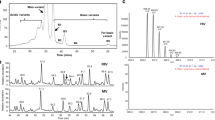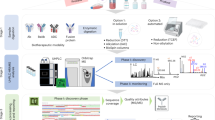Abstract
An amino acid sequence variant (SV) is defined as an unintended amino acid substitution in protein drug products. SVs contribute to product heterogeneity and can potentially impact product quality, safety, immunogenicity, and efficacy. The analysis of biotherapeutics for SVs is important throughout the product life cycle including clone selection, development of nutrient feed strategies, commercial manufacturing process, and post-approval changes to monitor product quality. The proposed analytical procedure for SVs consists of both qualitative (identification of SVs) and quantitative (quantitation of identified SVs) components. The complexities of SV analysis and the variety of current procedures highlight the need for a systematic approach for assessing the capability of these methodologies to reliably identify and quantitate SVs in biotherapeutics. We described here a “spike-control” approach for evaluating SV analytical procedure. The concept was adopted from quality control samples routinely used in analytical procedure validation. One FDA approved monoclonal antibody (mAb) was spiked with accurate amounts of highly homologous mAb to create mAb samples containing low yet accurate levels of “artificial” SVs. Spike-control samples were denatured, reduced, alkylated, digested and then analyzed by high resolution Orbitrap mass spectrometry. In silico analysis revealed four single amino acid differences between the two mAbs that could be used to represent SVs in the spike-control samples. All four “artificial” SVs were reliably identified by the current workflow. Analytical range (0.01% to 2%), accuracy and precision of identified SVs have also been evaluated. Overall, spike-control sample(s) helped to demonstrate that the SV analytical procedure (i.e., sample preparation, LC separation, mass spectrometry determinations and bioinformatic software) was fit for purpose and suitable for the identification and quantitation of SVs at a pre-determined threshold.



Similar content being viewed by others
References
Borisov OV AM, Carroll JA, Brown PW. (2015) Sequence variants and sequence variant analysis in biotherapeutic proteins. , in State-of-the-art and emerging technologies for therapeutic monoclonal antibody characterization Volume 2 Biopharmaceutical characterization: the NISTmAb case study pp 63–117, ACS Publications.
Brady LJ, Scott RA, Balland A. An optimized approach to the rapid assessment and detection of sequence variants in recombinant protein products. Anal Bioanal Chem. 2015;407:3851–60.
Easton RL. Structural characterization methods for biosimilars: fit-for-purpose, qualified or validated. Generics and Biosimilars Initiative Journal (GaBI Journal). 2022;11:41–4.
FDA (2019) Development of Therapeutic Protein Biosimilars: Comparative Analytical Assessment and Other Quality-Related Considerations Guidance for Industry.
Frye C, Deshpande R, Estes S, Francissen K, Joly J, Lubiniecki A, Munro T, Russell R, Wang T, Anderson K. Industry view on the relative importance of “clonality” of biopharmaceutical-producing cell lines. Biologicals. 2016;44:117–22.
Guo D, Gao A, Michels DA, Feeney L, Eng M, Chan B, Laird MW, Zhang B, Yu XC, Joly J, Snedecor B, Shen A. Mechanisms of unintended amino acid sequence changes in recombinant monoclonal antibodies expressed in Chinese Hamster Ovary (CHO) cells. Biotechnol Bioeng. 2010;107:163–71.
ICH (1999) ICH GUIDELINE Q6B: SPECIFICATIONS: Test procedures and acceptance criteria for biotechnological/Biological products.
ICH (2022) International Council for harmonisation of technical requirements for pharmaceuticals for human use: Validation of Analytical Procedures Q2(R2).
Liigand P, Kaupmees K, Kruve A. Influence of the amino acid composition on the ionization efficiencies of small peptides. J Mass Spectrom. 2019;54:481–7.
Lin TJ, Beal KM, Brown PW, DeGruttola HS, Ly M, Wang W, Chu CH, Dufield RL, Casperson GF, Carroll JA, Friese OV, Figueroa B Jr, Marzilli LA, Anderson K, Rouse JC. Evolution of a comprehensive, orthogonal approach to sequence variant analysis for biotherapeutics. MAbs. 2019;11:1–12.
Lund A, Ren D, Rogers RS, Rouse JC, Yu XC, Valliere-Douglass JF. Scientific Best Practices for Primary Sequence Confirmation and Sequence Variant Analysis in the Development of Therapeutic Proteins. J Pharm Sci. 2021;110:619–26.
Rathore AS, Zydney AL, Anupa A, Nikita S, Gangwar N. Enablers of continuous processing of biotherapeutic products. Trends Biotechnol. 2022;40(7):804–15.
Teams PMRDaCS (2021) Improving data review efficiency using automated labeling with byos validators: Sequence variant and post-translational modification analysis.
Thakur A, Nagpal R, Ghosh AK, Gadamshetty D, Nagapattinam S, Subbarao M, Rakshit S, Padiyar S, Sreenivas S, Govindappa N, Pai HV, MelarkodeSubbaraman R. Identification, characterization and control of a sequence variant in monoclonal antibody drug product: a case study. Sci Rep. 2021;11:13233.
Valliere-Douglass J, Marzilli L, Deora A, Du Z, He L, Kumar SR, Liu YH, Mueller HM, Nwosu C, Stults J, Wang Y, Yaghmour S, Zhou Y. Biopharmaceutical Industry Practices for Sequence Variant Analyses of Recombinant Protein Therapeutics. PDA J Pharm Sci Technol. 2019;73:622–34.
Wong HE, Huang CJ, Zhang Z. Amino Acid Misincorporation Propensities Revealed through Systematic Amino Acid Starvation. Biochemistry. 2018;57:6767–79.
Yang Y, Strahan A, Li C, Shen A, Liu H, Ouyang J, Katta V, Francissen K, Zhang B. Detecting low level sequence variants in recombinant monoclonal antibodies. MAbs. 2010;2:285–98.
Zhang Z, Shah B, Bondarenko PV. G/U and certain wobble position mismatches as possible main causes of amino acid misincorporations. Biochemistry. 2013;52:8165–76.
Zhang A, Chen Z, Li M, Qiu H, Lawrence S, Bak H, Li N. A general evidence-based sequence variant control limit for recombinant therapeutic protein development. MAbs. 2020;12:1791399.
Zhang Z, Shah B. Limited Proteolysis Coupled with Mass Spectrometry for Simultaneous Evaluation of a Large Number of Protein Variants for Their Impact on Conformational Stability. Anal Chem. 2021;93:14263–71.
Acknowledgements
This work was funded by the U.S. Food and Drug Administration, Center for Drug Evaluation and Research, Office of Pharmaceutical Quality. The authors thank Dr. Sarah Rogstad, Senior Scientific Advisor, Office of Testing and Research, Office of Pharmaceutical Quality, FDA/CDER, for critical comments.
Author information
Authors and Affiliations
Corresponding author
Ethics declarations
Conflicts of Interest
None of the authors has any personal or financial conflict of interest or has entered into any agreement that could potentially result in a conflict of interest due to their access to the data presented here, or on their ability to analyze the data independently, or to prepare and publish future manuscripts, based wholly or partially on these data.
Disclaimer
This publication reflects the views of the authors and should not be construed to represent FDA’s views or policies.
Additional information
Publisher's Note
Springer Nature remains neutral with regard to jurisdictional claims in published maps and institutional affiliations.
Rights and permissions
About this article
Cite this article
Zhang, J., Shih, M., Yan, H. et al. A Spike-Control Approach that Evaluates High Resolution Mass Spectrometry-Based Sequence Variant Analytical Method Performance for Therapeutic Proteins. Pharm Res 40, 1425–1433 (2023). https://doi.org/10.1007/s11095-023-03527-8
Received:
Accepted:
Published:
Issue Date:
DOI: https://doi.org/10.1007/s11095-023-03527-8




